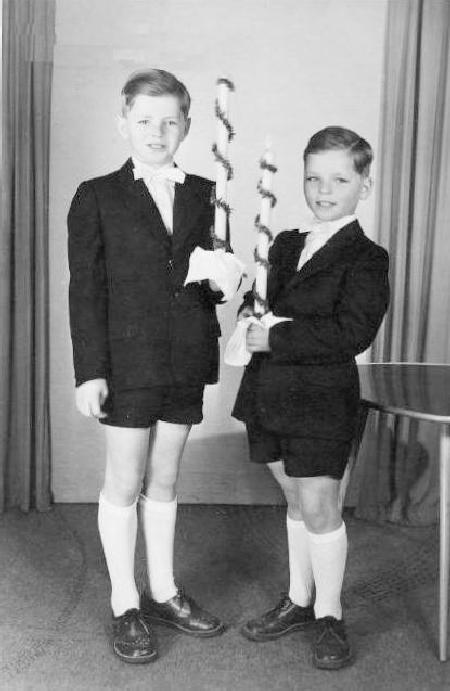German First Communion Chronology: The 1950s
HBC has little information on German First Communion outfits during the 1950s. We know that the German Economic Miricle occurred in the 1950s. Germany rebuilt its devestated cities and Germany families experienced wide-spread prosperity. Families could afford luxuries, including First Communion outfits for the children. The major churches were significantly impacted by the NAZI era and the War. There was an ibreasing secularization of German society, but in the 1950s this was jist beginning. There seems to have Both boys and girls tended to wear rather formal outfits. This was usually a dark or colored short pants suit worn with white knee socks for the boys. We see white suits, but they do not appear to have been very common. A few boys wore long pants suits, but they were not very common. Most boys wore knee socks with their First Communion suits. White knee socks seem especially popular. We do not see many boys wearing ankle socks or long stockings. We note girls wearing junior wedding dresses, always whites, for the girls. The boys could wear the suits for other occassions, but the girls dresses were outfits that could not be worn for many other occassions. Thus the appearance of such dresses was a sure indicator of German's revived prosperity. We see a ramge of ages doing First Communiuion. Some of the children look more like the age appropriate for conformation. We are not sure why that was.
Decade Trends
HBC has little information on German First Communion outfits during the 1950s. We know that the German Economic Miricle occurred in the 1950s. Germany rebuilt its devestated cities and Germany families experienced wide-spread prosperity. Families could afford luxuries, including First Communion outfits for the children. The major churches were significantly impacted by the NAZI era and the War. There was an ibreasing secularization of German society, but in the 1950s this was jist beginning. And most families wanted the children to do tradition religious commitments like First Communion and Confirmation. We have a few images that are dated and helpful in establishing decade trends. We note boys mostly wearing short pants suit. Some boys still wore long stockings with their suits at the beginning of the decade, but by mid-decade we see knee socks almost exclusively. Wealso mistly see caps in the early part of the decade. We also notice shorter cut pants becoming more popular during the decade.
Outfits
Both boys and girls in Germany tended to wear rather formal outfits for First Communiion in the 1950s. There were still a lot of confessional single gender schools. The boys usually wore a dark or colored suits, almost always short pants suits. Some boys had matching dark caps. We see white suits, but they do not appear to have been very common, especially at the beginning of the decade. Neckwear varied. We see both dar ties and white ties. Somev boys did not have neckwear. A few boys wore long pants suits, but they were not very common. And we see a few boys wearing sailor suits, sometimes with long pants. Hosiery changed during the decade, al least for the boys. At the beginning of the decade, black long stockings were still common for the boys. By the end of the decade we see mostly white knee socks. Curiously we do not see boys wearing either black knee socks or white long stockings.
Nor do we see many boys wearing ankle socks of any color. We note girls wearing junior wedding dresses, always whites, We note both white long stockings and white knee socks. White stiockings weredominant at the beginning of the decade, but we see knee socks by the end of the decade. The boys could wear the suits for other occassions, but the girls dresses were outfits that could not be worn for many other occassions. They were essentially worn once and then became a keepsake. Thus the appearance of such dresses were a sure indicator of German's new-found prosperity.
Ages
We see a ramge of ages doung First Communiuion. Some of the children look more like the age appropriate for conformation. Usually First Communion was for vhildren about 7-8 years of age, but there could be some varistion for various reasons such as wanting brithers or sisters to do it gtogether. Conformation was for children anout 13 years old. We see children who look to be as old as 13 years doing their First Communion. We are not sure why that was.
HBC
Navigate the Boys' Historical Clothing Web Site religious pages:
[Return to the Main German First Communion chronology page]
[First Communion]
[Confirmation]
[Ring bearer]
[Victorian wedding]
Navigate the Boys' Historical Clothing Web Site:
[Introduction]
[Activities]
[Biographies]
[Chronology]
[Clothing styles]
[Countries]
[Bibliographies]
[Contributions]
[FAQs]
[Glossaries]
[Images]
[Links]
[Registration]
[Tools]
[Boys' Clothing Home]
Navigate the Historic Boys' Clothing Web chronological pages:
[The 1900s]
[The 1910s]
[The 1920s]
[The 1930s]
[The 1940s]
[The 1950s]
[The 1960s]
[The 1970s]
[The 1980s]
[The 1990s]
Navigate the Historic Boys' Clothing Web style pages:
[Short pants suits]
[Blazers]
[Jackets]
[Kilts]
[Sailor suits]
[Sailor hats]
[Ring bearer/page costumes]
[Shortalls]
Created: 10:56 PM 6/21/2008
Last edited: 6:55 AM 8/21/2011


